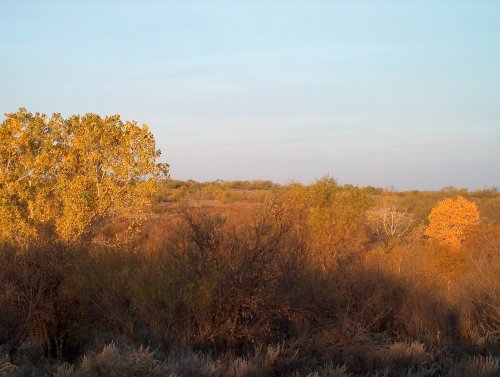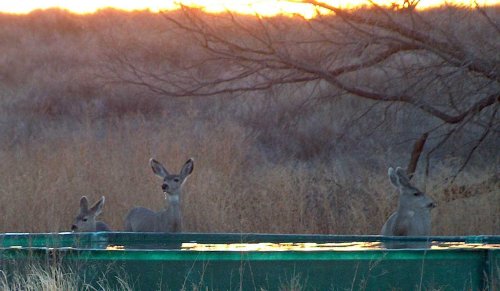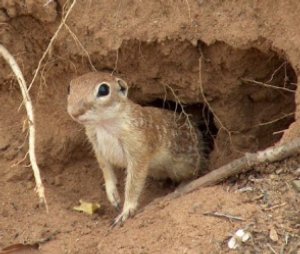Matador WMA
Phone: (806) 492-3405
Address:
3036 FM 3256
Paducah, TX 79248
Contact:
Chip Ruthven
Dates Open:
Year round.
Exception: Entire Area Closed for Special Permit Hunts
Connect with the Matador WMA on Facebook.
Description
The Matador Wildlife Management Area (MWMA) is located in the central Rolling Plains of Cottle County, Texas. Using Pittman-Robertson funds, the 28,183-acre MWMA was purchased by the Texas Parks and Wildlife Department in 1959 for the purposes of wildlife research, wildlife management, and public use.
Habitat types include mesquite uplands, shinnery oak rangeland and gravelly hills consisting of red berry juniper and mesquite mix, and bottomland. Average annual rainfall is 22 inches, with the greatest precipitation normally occurring in May and June.

A fall sunrise over O.X. Creek
on the Matador WMA, highlighting the colorful cottonwoods trees.
Public use activities include hunting, fishing, hiking, bird watching, camping, horseback riding, nature study, and photography. All visitors must register upon arrival at the registration building (open 24 hours) and check out when leaving. All visitors, 17 years old and older, must possess an Annual Public Hunting APH Permit or a Limited Public Use LPU Permit. These permits are available from any license vendor. Visitors under 17 years old must be accompanied by a person 18 years of age or older in possession of one of the permits. Tours of the MWMA can be arranged for groups by contacting the Area Manager. Tours are not available during public hunts.
Numerous wildlife species occur on the MWMA, including bobwhite quail, Rio Grande turkey, scissor-tailed flycatchers, Bullock's orioles, Mississippi kites, roadrunners, mourning doves, painted buntings, western diamondback rattlesnakes, western massasauga rattlesnakes, Texas horned lizards, ornate box turtles, mule and white-tailed deer, coyotes, bobcats, and feral hogs. Rare species sighted on the area include vermilion flycatchers, pyrrhuloxia, mountain lions, pronghorn, and javelina.
Students, teachers, and scientists use the MWMA for instructional, educational, and research purposes. Do not disturb any markings, flags, traps, etc. that you encounter, as this may affect results.

Mule deer using one of many watering facilities on the Matador WMA.
Some areas on the MWMA are inaccessible with 2-wheel drive vehicles. Therefore, 4-wheel drive vehicles are recommended to gain access to these remote areas. Signs are posted on roads where 4-wheel drive vehicles are required.
All visitors are encouraged to bring plenty of drinking water. Those wishing to camp should bring camp stoves, since droughty conditions often prohibit open fires. Electrical hookups and showers are not available. Foot protection for dogs is often recommended due to grass burs. It is also recommended that dogs have a collar and tag with the owner's name, address, and phone number in the event the dog is lost.
Whether you are hunting, hiking, or bird watching, we hope you enjoy your visit on the Matador WMA.

A spotted ground squirrel at the Matador.
- All visitors are encouraged to bring plenty of drinking water.
- Those wishing to camp should bring camp stoves, since droughty conditions often prohibit open fires.
- Electrical hookups and showers are not available.
- Foot protection for dogs is often recommended due to grass burs.
- It is also recommended that dogs have a collar and tag with the owner's name, address, and phone number in the event the dog is lost.